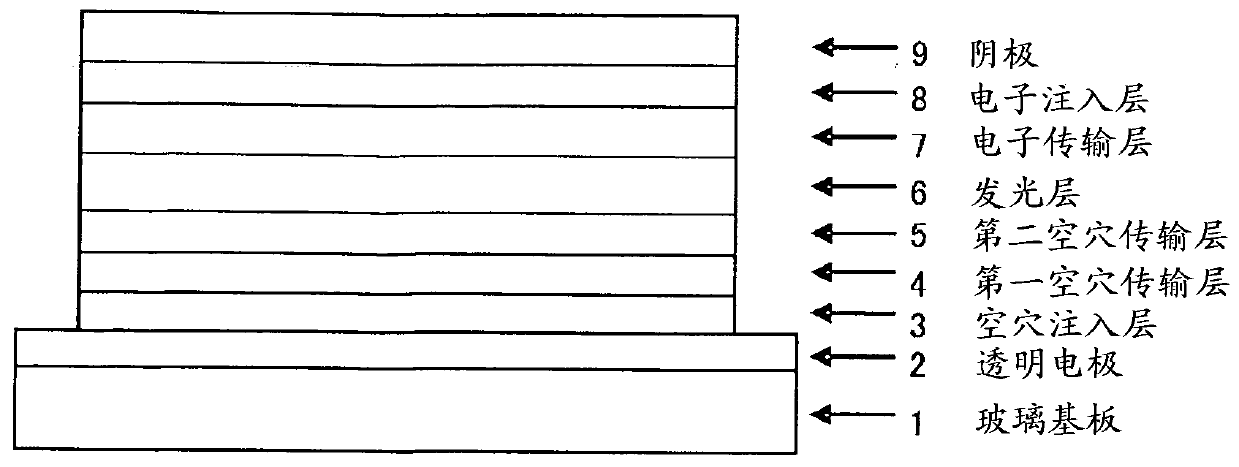Organic electroluminescent element
An electroluminescent component, an organic technology, applied in the direction of electrical components, luminescent materials, organic chemistry, etc., can solve the problems of reduced component characteristics, insufficient, low driving voltage, etc.
- Summary
- Abstract
- Description
- Claims
- Application Information
AI Technical Summary
Problems solved by technology
Method used
Image
Examples
Embodiment 1
[1037]
[1038] Add 11.8 g of bis(biphenyl-4-yl)-(6-bromobiphenyl-3-yl)amine, 94 ml of toluene, 2.7 g of phenylboronic acid, and 5.9 g of potassium carbonate dissolved in 36 ml of water in advance Nitrogen gas was flowed into the reaction vessel replaced with nitrogen while irradiating ultrasonic waves for 30 minutes. 0.74 g of tetrakis(triphenylphosphine)palladium was added, heated, and stirred at 72° C. for 18 hours. After cooling to room temperature, an organic layer was obtained by a liquid separation operation. After washing with water and washing with saturated brine in this order, it was dried over anhydrous magnesium sulfate and concentrated to obtain a crude product. Next, by performing purification using column chromatography, a white powder of bis(biphenyl-4-yl)-(1,1':2,1"-terphenyl-4-yl)amine (compound 1-1) was obtained 8.4 g (72% yield).
[1039] [chem 465]
[1040]
[1041] For the obtained white powder, the structure was identified using NMR.
[1042] us...
Embodiment 2
[1045]
[1046] In Example 1, 1-naphthylboronic acid was used instead of phenylboronic acid, and the reaction was carried out under the same conditions to obtain bis(biphenyl-4-yl)-{6-(naphthyl-1-yl)bis 9.2 g of white powder (yield 61%) of phen-3-yl}amine (compound 1-2).
[1047] [chem 466]
[1048]
[1049] For the obtained white powder, the structure was identified using NMR.
[1050] use 1 H-NMR (CDCl 3 ) detected the following 33 hydrogen signals.
[1051] δ (ppm) = 7.84-7.87 (3H), 7.67-83 (6H), 7.26-7.64 (18H), 7.02-7.04 (6H).
Embodiment 3
[1053]
[1054] In Example 1, instead of phenylboronic acid, (9,9-dimethylfluoren-2-yl)boronic acid was used, and the reaction was carried out under the same conditions to obtain bis(biphenyl-4-yl)-{6 -9.0 g of white powder of (9,9-dimethylfluoren-2-yl)biphenyl-3-yl}amine (compound 1-3) (yield 57%).
[1055] [chem 467]
[1056]
[1057] For the obtained white powder, the structure was identified using NMR.
[1058] use 1 H-NMR (CDCl 3 ) detected the following 39 hydrogen signals.
[1059] δ (ppm) = 7.56-7.64 (10H), 7.26-50 (18H), 7.02-7.16 (5H), 1.26 (6H).
PUM
| Property | Measurement | Unit |
|---|---|---|
| glass transition temperature | aaaaa | aaaaa |
| glass transition temperature | aaaaa | aaaaa |
| thickness | aaaaa | aaaaa |
Abstract
Description
Claims
Application Information
 Login to View More
Login to View More - R&D
- Intellectual Property
- Life Sciences
- Materials
- Tech Scout
- Unparalleled Data Quality
- Higher Quality Content
- 60% Fewer Hallucinations
Browse by: Latest US Patents, China's latest patents, Technical Efficacy Thesaurus, Application Domain, Technology Topic, Popular Technical Reports.
© 2025 PatSnap. All rights reserved.Legal|Privacy policy|Modern Slavery Act Transparency Statement|Sitemap|About US| Contact US: help@patsnap.com



